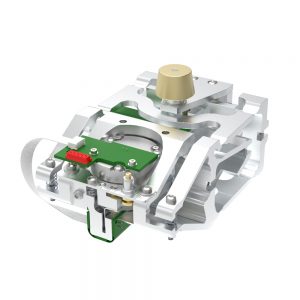The Ecologic and Economic Benefits of a Hybrid Weighing Cell in Balances, Scales, and Industrial Applications
Not prominently visible, weighing cells are being used in a wide range of industries and working places. From being implemented in conveyor belt systems, industrial scales, or laboratory balances, the weighing cell is the most important component for precise mass determination. The evolution of the weighing cell starts with the substitution balance which has been replaced by the electromagnetic force compensation (EMFC) principle. Further development went into the direction of monolithic weighing cell design and the latest technology is a hybrid solution, offering ecologic and economic benefits.
The Conventional Force Compensation Cell
The conventional EMFC weighing cell is a reliable technology used for many years throughout the market. Depending on the construction plan and on the intended accuracy, it can be very challenging to assemble this weighing cell containing many different interdependent parts. The advantage is a high repairability however, a wide range of spare parts available and skilled service technicians are required. Furthermore, it is very sensitive to shocks or other negative environmental influences.
The Monolithic Weighing Cell
While the conventional EMFC cell was state-of-the-art for decades, in the most recent years a shift towards monolithic cells was noticeable. Monolithic weighing cells are composed of one single piece of metal (mostly strong aluminum alloy) where further components and electronic parts are being inserted and mounted to. One benefit over the pure EMFC cell is a more stable and reliable measuring result due to homogenic material and therefore a favorable temperature coefficient. The low complexity throughout the production and assembly process is accountable for low labor costs. The downside of this type of weighing cell is the material- and energy-consuming fabrication method since the cell is generally cut out of one block either by milling or electrical discharge machining process (EDM). During this process it can occur that up to 65% of the material has to be milled away to get the desired outcome. The impossibility to repair the monolithically constructed cell results in disposal of the entire cell and in some cases even the installed signal detection electronics needs to be replaced in case of a defect. This is generating metal and electronic scrap and therefore a loss of valuable resources.
The Hybrid Solution
The desire to combine the advantages of simple repairability with robust cell design which can be comfortably assembled, resulted in the development of a hybrid weighing cell. The core of this type of cell is a robust chassis which holds several layers made from even stronger material to withstand the forces which occur during the weighing process. Where the monolithic cell is only as strong as the weakest link in the chain, the benefit of the hybrid setup is that the strength of each of the components can be chosen individually, depending on the stress they will be exposed to. This reduces the strength needed for certain parts and therefore makes the production of the raw material and the forming of the desired part shape less energy intensive. Additionally, the optimal thermal and mechanical manufacturing procedures can be applied to each layer accordingly. In a subsequent step, the components receive their specific finish, also according to future stress exposure (e.g. introduction of weight force into the sensor) for every single part. Compared to the conventional EMFC cell the hybrid solution includes far less components and every single part can be exchanged. Therefore, the weighing cell can be repaired instead of simply disposing it.
In summary, the advantages of a hybrid weighing cell are:
• Optimal choice of raw material (production and process)
• Limited amount of parts
• Optimal combination of manufacturing processes
• Choice of the optimal cell design
• Decreased need for specially finished parts
• Easy assembly and reparation
• Reduction of material (use, waste, recycling)
• Reduction of costs
PHASTbloc™ Weighing Cell as an Ecologic and Economic Solution
A new type of hybrid weighing cell is the PHASTbloc™ (Precisa Hybrid Advanced Sensor Technology). It is composed of three monolithic functional layers. The chassis is not milled or cut out of a solid bloc of aluminum per EDM method but produced through extrusion process. This makes the biggest layer only as robust as it must be and therefore reduces the energy consumption of raw material production. The raw material can be delivered en-bloc to the manufacturer and the extrusion process allows an ideal material yield and therefore a good material utilization grade (70 – 75%). Since this part is being manufactured locally transportation costs and the use of resources can be kept to a minimum. The two stronger layers receive an individual finish. Also here, size of components and manufacturing processes are being optimized where again resource and energy consumption is being kept as low as possible. The PHASTbloc™ system can be scaled up to be used for larger weight loads of bigger platform scales (e.g. in the industrial sector), where pure monolithic solutions are facing limitations. Assembly and disassembly are very intuitive and therefore does not require highly skilled technicians. This allows easy reparation and an exchange of just the damaged parts. This also adds to the sustainability of balances with this type of weighing cell.
The innovative PHASTbloc™ design is a collaboration with the ZHAW, University of Applied Science Zürich and was awarded and supported by the Swiss Commission for Innovation and Technology.
Precisa’s 520 Analytical Balances with PHASTbloc
If you have enjoyed reading about the ecologic and economic benefits hybrid weighing cells , and wish to try yourself, view our 520 Series Balances. For further information, please contact us and a member of our team will be delighted to assist you.
Grolimund, R., 2011. Konzepte monolithischer Wägezellen – Zusammenfassung bestehender Lösungen und Konzeptideen zu Alternativkonzepten. pp. 2 – 10.
Marangoni, R. et al, 2017. Analysis of weighing cells based on the principle of electromagnetic force compensation. Meas. Sci. Technol. 28 075101. pp. 3 – 9




